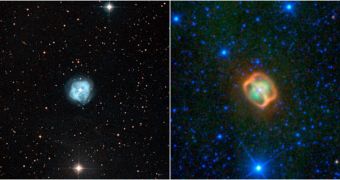A team of astronomers managed to obtain an impressive new view of a distant cosmic structure, which features two stars locked in a deadly dance. The two bodies are surrounded by a massive cloud of gas and dust, which makes it resemble a cosmic jellyfish.
The experts used the NASA Wide-field Infrared Survey Explorer (WISE) telescope to capture the amazing view of the Crystal Ball nebula, which is known among astronomers as NGC 1514.
The object is located relatively close-by in astronomical terms, at a distance of about 800 light-years away, in the direction of the constellation Taurus. It contains vast amounts of fluorescing gas trapped within, as well as two unusual rings, which captured the attention of astronomers.
A cosmic object such as this one has never been imaged before, researchers say, which is what makes the WISE image so important for science. Experts might be able to discover new phenomena happening around stars that they had no idea existed before.
“I am reminded of the jellyfish exhibition at the Monterey Bay Aquarium – beautiful things floating in water, except this one is in space,” explains the WISE mission principal investigator, Ned Wright.
The expert holds an appointment at the University of California in Los Angeles (UCLA), and is also a co-author of a new study detailing the findings, which appears in a recent issue of the esteemed Astronomical Journal, Space reports.
Objects such as NGC 1514 develop when dying stars shed the outer layers of their atmosphere in the space around them. In this case, both members of the binary system do the same, giving birth to a unique view.
Both celestial fireballs then heat the gas up from within, making it fluoresce, and therefore very visible in the infrared portion of the electromagnetic spectrum.
Experts explain that the rings visible around this particular nebula were produced when the dust and gas emitted by the two stars slammed against the walls of a cavity-like structure surrounding the stars.
The “cavity” was produced when the stars were younger, and their strong stellar winds cleared a path in the space around it, leaving it empty. Now, dust travels through this space, and then hits the interstellar environment.
This causes it to swirl, and therefore produce the rings that the new images reveal. “This object has been studied for more than 200 years, but WISE shows us it still has surprises,” says Michael Ressler.
The expert is based in Pasadena, California, at the ASA Jet Propulsion Laboratory (JPL), which manages the WISE mission for the NASA Science Mission Directorate, in Washington DC. Ressler is also the lead author of the research paper.

 14 DAY TRIAL //
14 DAY TRIAL //